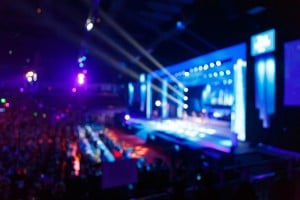To Achieve the “Wow Factor” with your Conference, Ace the Audio-Visuals
By
Even with the world’s greatest keynote speaker, a poor setup and lousy audio-visuals can ruin your conference. Properly producing your event reinforces your brand and shows attendees your attention to detail and to their comfort. To impress your guests, get a handle on several critical areas that bring your conference to life.
Stage setup
At too many conferences, it’s impossible for the audience to tell what’s going on. A number of factors can make presentations difficult to see, hear and follow for your audience: too many people on stage, unreadable signage, terrible audio, bad angles and others. As you’re setting up your stage, walk to all corners of the room and consider how difficult it will be to see and hear from your audience’s vantage.
Ideally, you’ll want to work with a professional stage manager to coach your speakers in advance on the ideal spots for standing and the best times during their presentations to move to various points on the stage. At a minimum, have your speakers run through their talks as you observe from different points in the room to gauge how the presentations will appear to your audience. Your goal is to have no bad seats in the house. For a room that’s simply too big to allow people in the back to see and hear everything well, you’ll need to plan for large monitors placed for optimal viewing.
Lighting
At a minimum, your lighting should highlight your speaker or speakers in a way that minimizes glare and distracting shadows. If your event is taking place in a large venue that typically hosts conferences, you should have a choice of lighting options. Ideally, the venue will have a lighting technician who can assist you.
If your speaker requires a podium, make sure there’s a small light on the podium itself for the speaker to view her notes easily. Try to hide the light from audience view to avoid distraction by changing the angle or placement as needed.
To avoid glare and to ensure that your audience can view the stage without discomfort, ensure that the lights around the stage aren’t excessively bright. A spotlight in front of the podium, on the floor, creates a focal point for your audience.
As with your general stage setup, take time to walk around the room to view different lighting configurations from various angles.
Audio
Few things at a conference are worse than sitting through a presentation you can’t hear. First and foremost with your audio, you want to ensure that people in the back aren’t yelling “Can’t hear you!” As with your lighting, it may be that your venue employs an audio technician or at least a generalist in audio-visuals who can assist you.
Audio presents multiple challenges that can vary depending on the size of your room, the layout, the number of people you expect, the general acoustics, microphone placement and other factors.
Whether or not a technician is available to help you, you’ll need to practice with varying settings and microphone placements. Have your speaker run through her talk as you listen from various parts of the room to ensure that her voice is clear, loud and not muffled. If you’ll be using lavalier microphones, be sure to let your speakers know what type of clothing will work best; generally collared shirts or jackets are ideal with clip-on mics.
As Entrepreneur notes, you’ll know your audio is working well if no one in your audience mentions it.
Visuals
Nearly everyone has endured a talk in which the speaker simply reads from PowerPoint slides. It’s not fun, and it’s certainly not memorable. PowerPoint remains the industry standard for presentation graphics, so it’s wise to provide your speakers with some tips for making the most of this workhorse software.
As Harvard Business Review advises, keep slides as simple as possible, and don’t use a slide deck in lieu of notes. To avoid repetitiveness, speakers should not repeat words that appear on the slides.
Many great speakers don’t even use slides, opting instead to simply let their words and their personality speak for themselves. Short of using no slides, the best plan is to show very simple graphics or photos that reinforce the message.
A number of alternatives to PowerPoint have appeared in recent years, and they offer some interesting options. For instance, Prezi offers a zooming bird’s-eye view of a two-dimensional map of presentations. Speakers can set up the presentation to glide around the screen from element to element, keeping your audience’s interest and boosting visual punch. Video also can be used effectively in presentations, but only if it’s kept short. Clips should be no more than a minute each to avoid the audience losing interest.
Try to get your speakers’ slides in advance, although that’s easier said than done. Having a little time to look through the slides and correct errors can avoid embarrassment for both you and your speakers.
More than one way to succeed
There’s really no one way to ace the audio-visuals for your conference. It’s critical that your audience be able to see and hear what’s going on. Beyond that, the impact of your stage setup, audio, lighting and visual components are only limited by your creativity and budget. The best talks offer audiences fresh ways of presenting, so don’t be afraid to try something new.
Source
http://www.entrepreneur.com/article/247821, https://hbr.org/2013/06/how-to-give-a-killer-presentation, http://www.ehow.com/how_7572142_light-podium.html, https://prezi.com/

